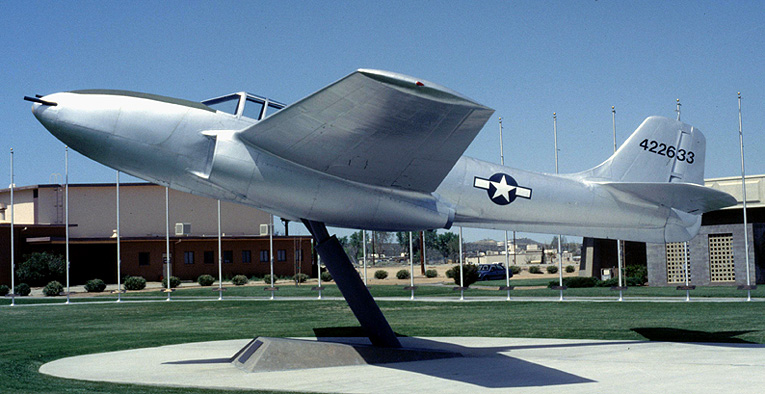
The Italian Aerospace Information Web
by Aeromedia - corso Giambone 46/18 - 10135 Torino (Italy)
Bell Model 27 P-59B Airacomet 44-22663 dell’Air Force Flight Test Center Museum esposto all’Edwards Air Force Base, in California. L’Airacomet fu il primo aereo a reazione costruito negli Stati Uniti, ed il primo caccia alleato a volare, tra quelli progettati fin dall’inizio per il nuovo tipo di propulsione. I tre prototipi XP-59 erano spinti da due turbogetti centrifughi General Electric 1-A da 1,400 libbre di spinta statica, costruiti su brevetti dell’inglese Whittle. I motori erano montati sotto l’ala, vicino ai fianchi della fusoliera. Il primo volo fu effettuato il 2 ottobre 1942 dal remoto Muroc Army Airfield (oggi Edwards AFB), situato sui bordi di un grande lago essiccato nel deserto californiano del Mojave. Sottopotenziato, l’Airacobra non diede risultati complessivamente soddisfacenti e non raggiunse lo stadio dell’impiego operativo. Ne venne comunque prodotta una piccola serie (29) nella versione armata P-49A, con turbogetti da 1.650 libbre General Electric I-16, poi ridesignati J31-GE-3. Gli ultimi nove esemplari costruiti, poi ridenominati P-49B, adottarono il J31-GE-5 da 2.000 libbre e serbatoi interni più capienti. Le consegne si conclusero nel maggio 1945. Gli Airacomet furono comunque utilizzati proficuamente per varie sperimentazioni e per familiarizzare i piloti al nuovo tipo di propulsione. Dimensioni del caccia intercettore/caccia-bombardiere monoposto Bell P-59B Airacomet con due turbogetti J31-GE-5: apertura alare 13,85 m; lunghezza 11,83 m; altezza 3,75 m; superficie alare 35,84 m2. Pesi: a vuoto 3.606 kg; normale al decollo 4.908 kg; massimo al decollo 5.760 kg. Prestazioni: velocità massima 359 nodi (664,8 km all’ora) a 30.000 piedi di quota (9.144 m); velocità massima di crociera 325 nodi (602 km all’ora) sempre a 30.000 piedi. Raggio d’azione con carburante interno - al 60% della potenza (260 nodi, 481 km all’ora), a 20.000 piedi – 208,5 miglia nautiche (386 km). Armamento: un cannone da 37 mm e tre mitragliatrici da 0.5 pollici nel muso, più due bombe da 1.000 libbre od otto razzi da 60 libbre, su due piloncini subalari. (Aeromedia)
Bell Model 27 P-59B Airacomet 44-22663 of Air Force Flight Test Center Museum on display at Edwards Air Force Base, in California. The Airacomet was the first turbojet-powered aircraft to be built in the United States, and the first Allied jet fighter to fly designed from the outset for the new type of propulsion. Three XP-59 prototypes were manufactured, each powered by two 1,400 lb static thrust General Electric 1-A centrifugal turbojets, based on British Whittle patents. The under-wing engines were placed close to the fuselage. The first flight took place on October 2, 1942, at Muroc Army Airfield (now Edwards AFB), located in a remote Californian dry lake in the Mojave Desert. The Airacobra was underpowered and performed below expectations, preventing its entry into active service. However a batch of 29 P-59A series aircraft was produced, with armament provision and improved 1,659 lb s.t. General Electric I-16 turbojets, later redesigned as J31-GE-3. The nine final aircraft had the 2,000 lb s.t J31-GE-5 variant and increased internal fuel capacity. Their designation was soon changed to P-59B. Deliveries of the Airacomet were completed by May 1945. The aircraft was valuable in providing experience with jet aircraft operations and in furnishing a number of trained jet pilots. Dimensions of the Bell P-59B Airacomet single-seat interceptor fighter and fighter-bomber powered by two J31-GE-5 turbojets: wing span 13.85 m (45 ft 6 in); length 11.83 m (38 ft 10 in); height 3.75 m (12 ft 4 in); wing area 35.84 sm (385.8 sq ft). Mass: empty 3,606 kg (7,950 lb); loaded 4,908 kg (10,822 lb); max T.O. 5,760 kg (12,700 lb). Performance: maximum speed 359 knots (664.8 km/h, 413 mph) at 30,000 ft (9,144 m); maximum cruising speed 325 knots (602 km/h, 375 mph) at 30,000 ft (9,144 m). Maximum range - with internal fuel, at 60% power (260 kt, 481 km/h), at 20,000 ft – 208.5 nm (386 km, 240 ml). Armament: nose-mounted array consisting of one 37-mm cannon and three 0.5-in machine guns and two 1,000-lb bombs or eight 60-lb rockets on underwing hard-points. (Aeromedia)
